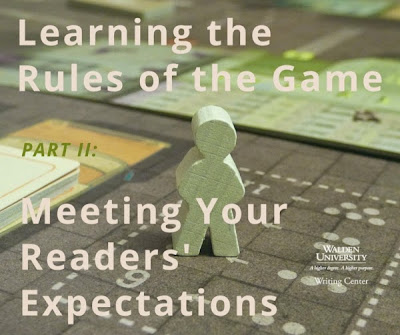Learning the Rules of the Game, Part 2: Meeting Your Readers' Expectations
In the Writing Center, we talk a lot about following an
academic rhetorical style; we typically call it scholarly writing or academic
writing. Basically, scholarly writing includes a number of norms and
guidelines, some of which are often not explained as requirements in assignment
prompts. In an academic setting, readers expect that the writing will follow the
rules of scholarly writing. The reader may be confused or have a hard time reading
and understanding a written work if it does not follow what is typical and
expected for the genre. Following these
rules means you will be more successful at effective communication in an
English academic environment. It might also help your grade. Nice perk,
right?
So, if you’re wondering where to start, let me give you a
few of the norms and guidelines. You can
find a lot more about how to effectively follow the rules of academic writing
in English in our website section on scholarly writing.
Norms and guidelines of scholarly writing
1. Organization
In English academic writing, readers expect to see an introductory
paragraph or section in which the
writer discusses the main idea of the paper and includes a thesis statement
that is concise, specific, and arguable. Academic writing in English is very
straightforward. In the introduction, the writer should tell the reader about the
main idea of the paper and what she or he is going to discuss in the paper.
Each body paragraph within the paper should have one clear
focus that relates back to the purpose of the paper, as stated in the thesis
statement. Within each paragraph, there should not be any extra information
that does not relate to the purpose/focus of the paragraph.
Finally, it is common to include a conclusion paragraph or
section that sums up the ideas from the paper and also may relate the
information in the paper to a larger purpose, such as the current research in a
field or possible future implications.
2. Tone
Use clear language that will easily be understood by the
reader. Using casual wording and contractions may make your draft sound
informal. Also, avoid metaphors because they may not be universally
understood.
3. Audience
When writing in an English academic context, as a general
rule, do not assume that the reader has the same background knowledge as you
do. It is the writer’s role to fully explain ideas so that the reader, who may
have little contextual or background information about the topic, can
understand the ideas in the paper. Including an introduction that addresses the
overall topic of the paper is one important step in providing some background
information for the reader. Also, as you mention ideas, theories, or
terminology for the first time in a draft, explain what they are or what they
mean to the reader. For more discussion about how and why to consider your audience when you write, check out Hillary's blog post.
4. Giving credit (aka citing sources)
In English academic writing, readers will expect that you
will often use evidence and ideas from other writers, researchers, and
organizations to support your arguments. When doing so, you need to always
explain where you read about or found the information. Citing sources is a way
to acknowledge the hard work of the people who researched a topic before you. Also,
it builds your credibility as an author and researcher if you can show that
there is evidence to support your arguments. If writers do not accurately cite
sources, they commit plagiarism, which can have harsh consequences. You can
learn more about effectively citing sources by viewing our archived webinar Using and Crediting Sources in APA.
By making sure that you have clear organization, a scholarly
tone, an idea of the audience for your draft, and citations for your sources,
you will be on the right track to ensure that you meet the expectations of your
readers, effectively communicate your ideas, and be successful throughout your
academic career.
We're always looking for ways to improve our resources. If you're a current international and/or multilingual Walden student, please take our brief survey to help us improve our services for you. The survey link will remain posted here as long as the survey is active. Thank you!
.jpg)
Amy Lindquist is a writing instructor in the Walden University Writing Center. She enjoys working with students from around the world on academic writing and the English Language. She's a bit of a grammar nerd. When not working, she spends time practicing yoga, sewing, and playing with her new puppy, Bauer.
.png)
Never miss a new post; Opt-out at any time
Subscribe to:
Post Comments
(
Atom
)
.png)





No comments :
Post a Comment